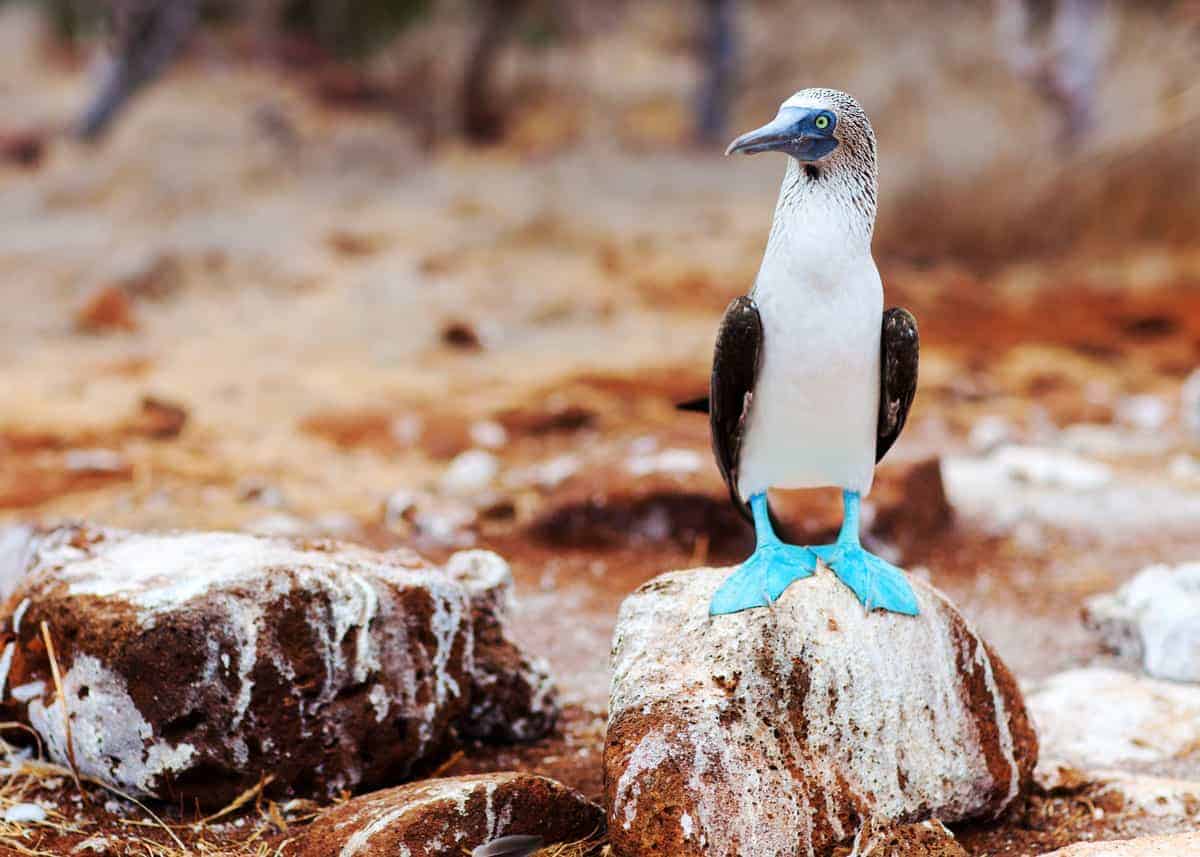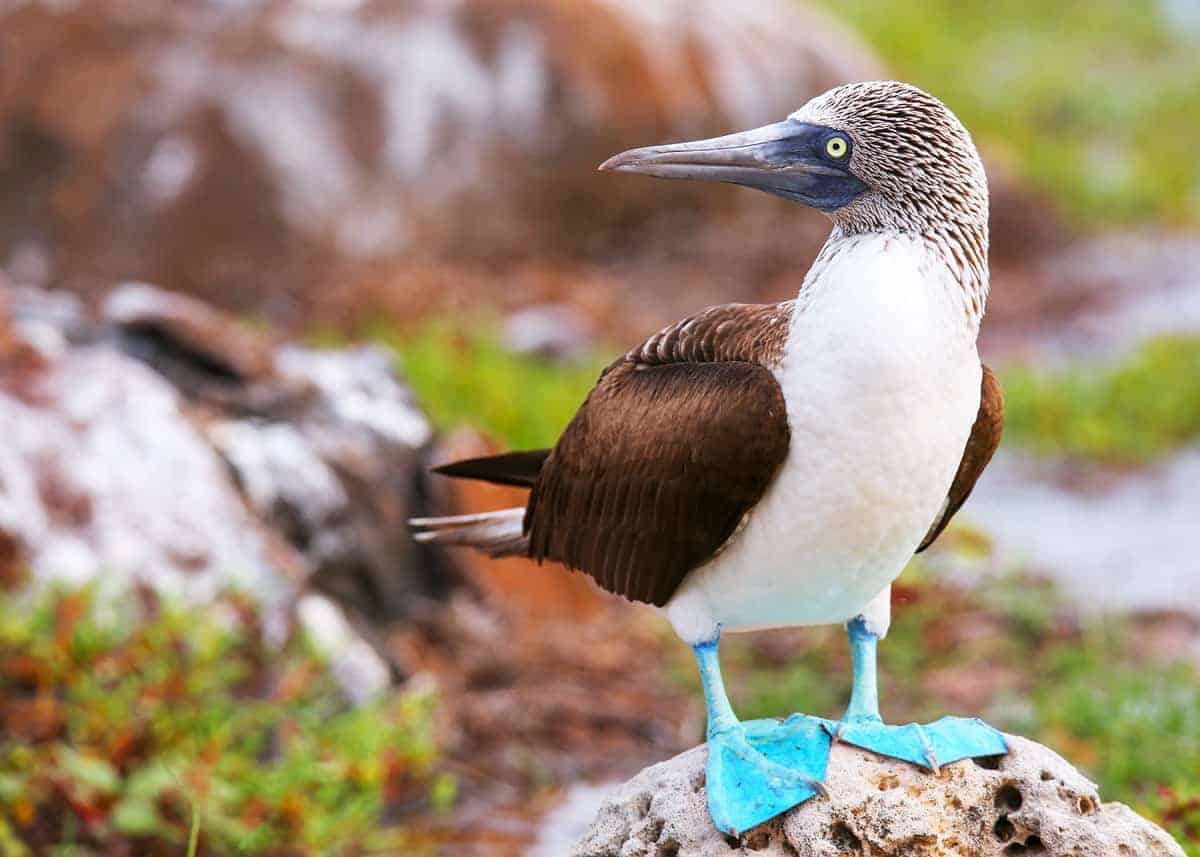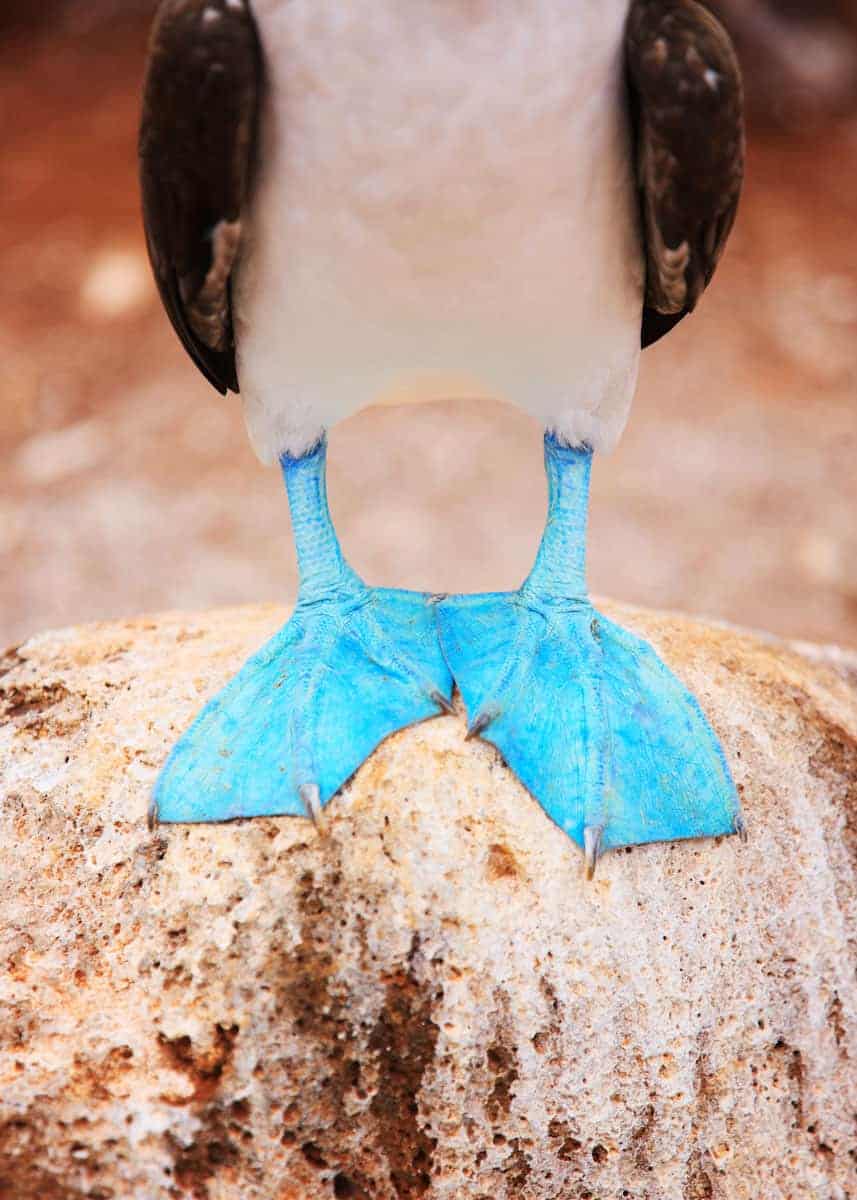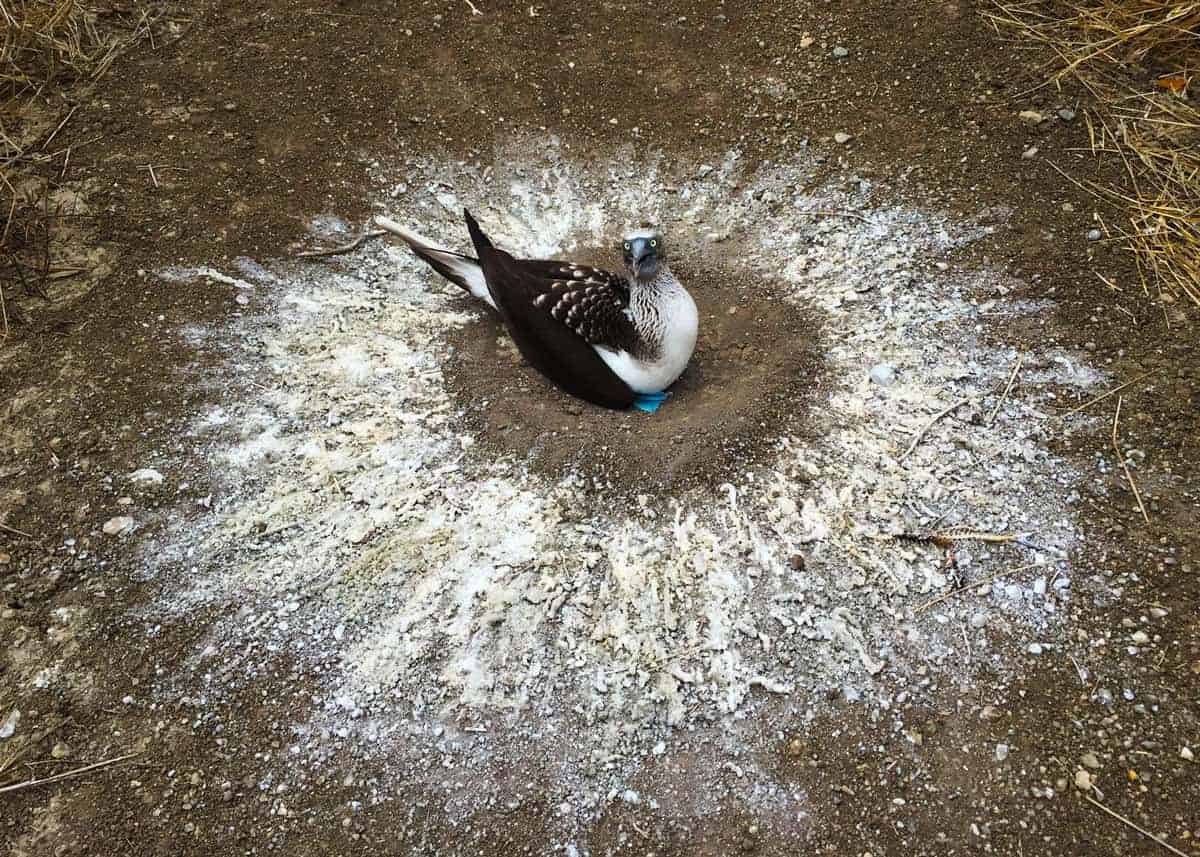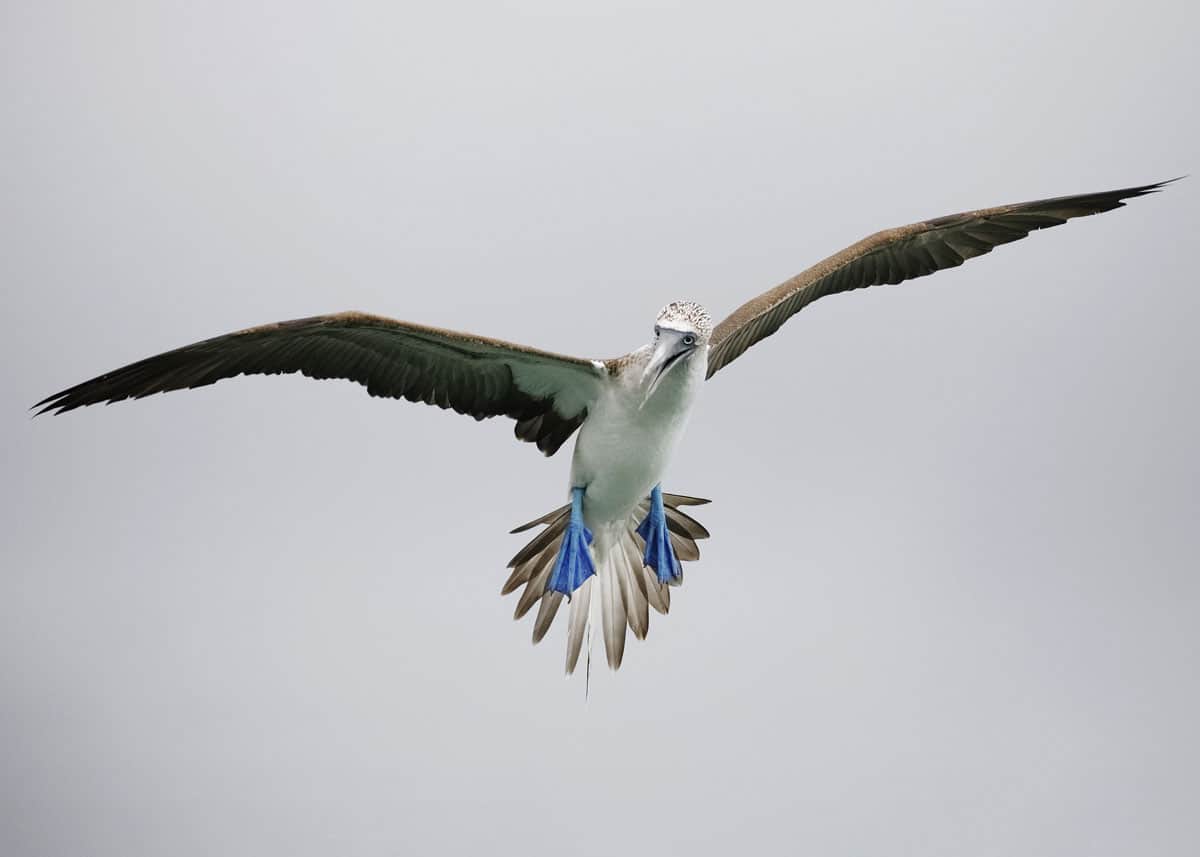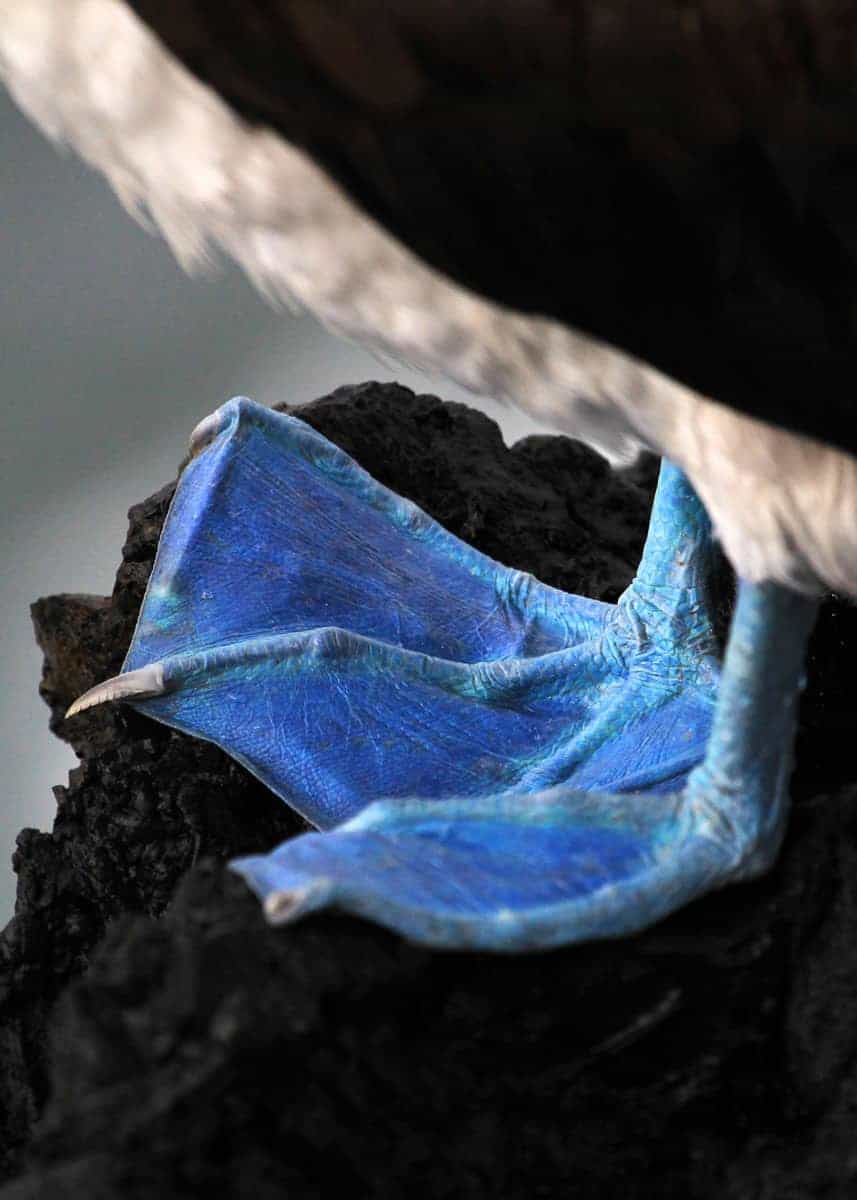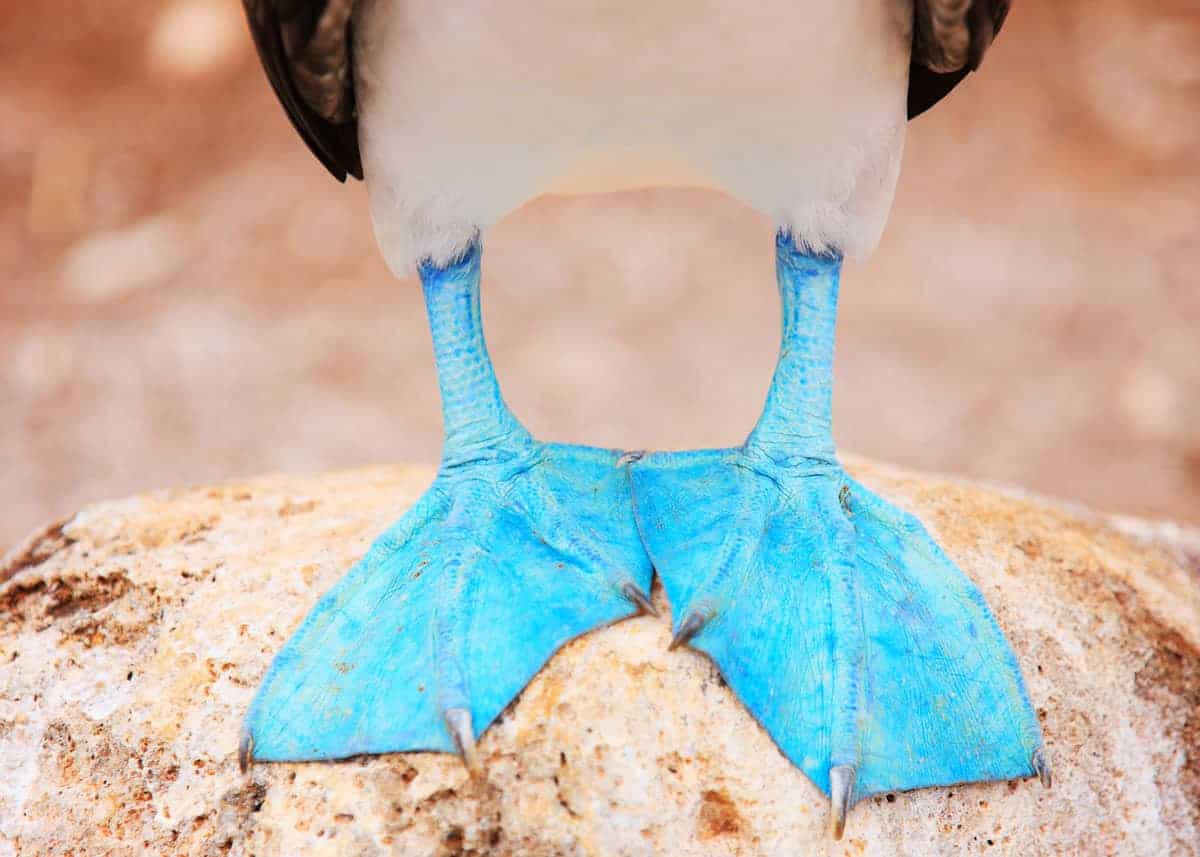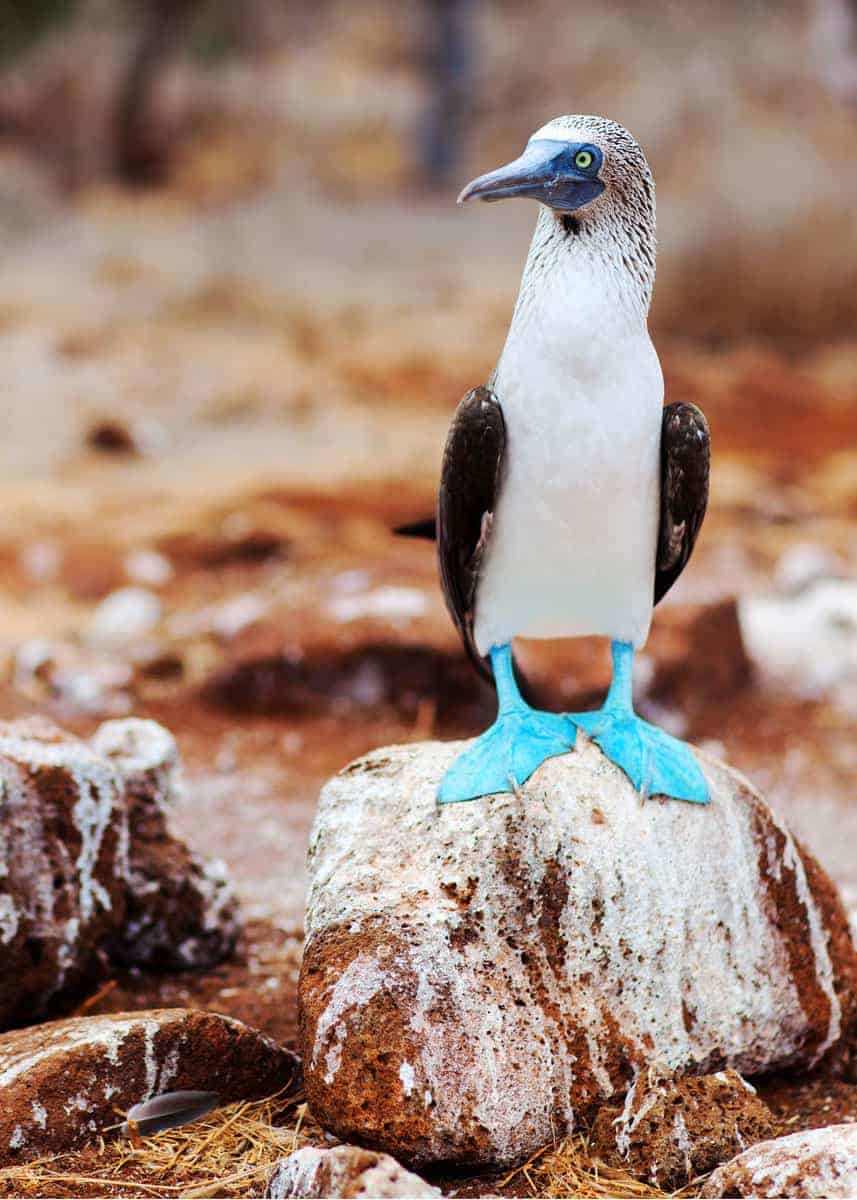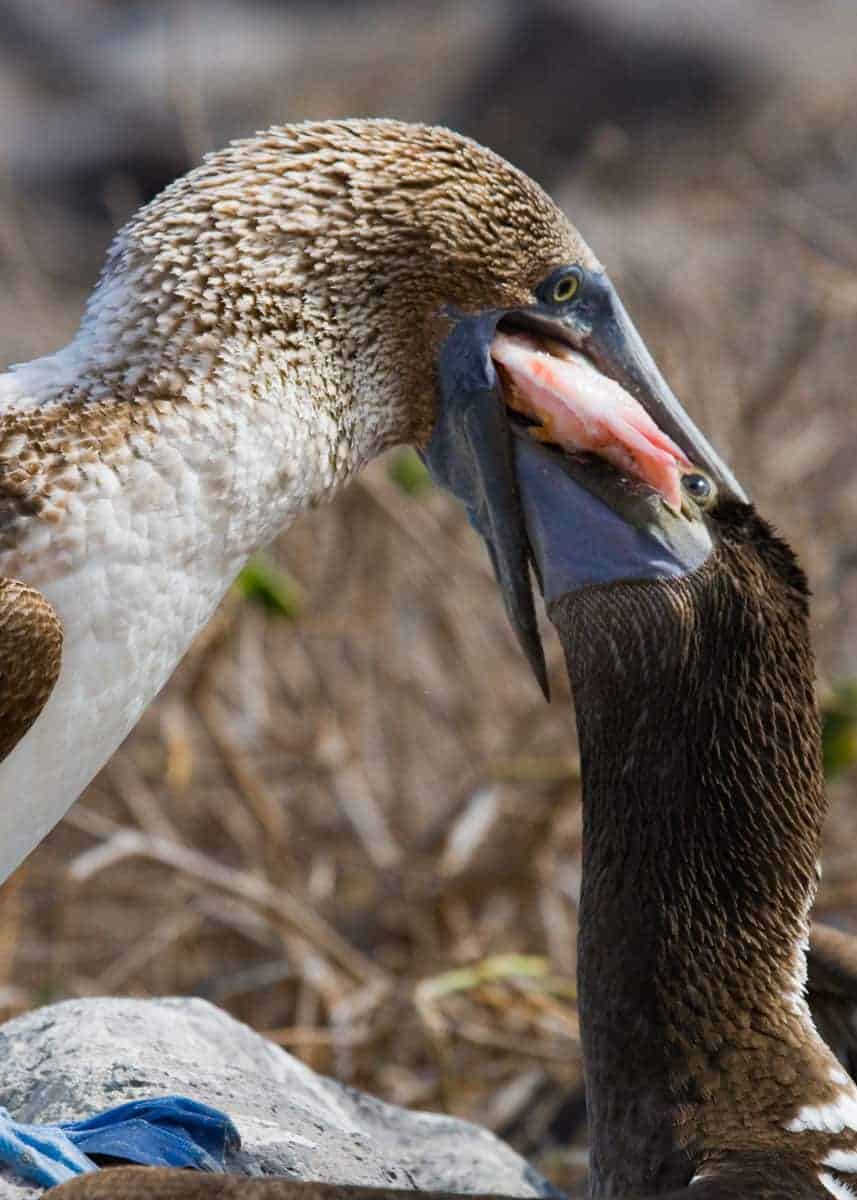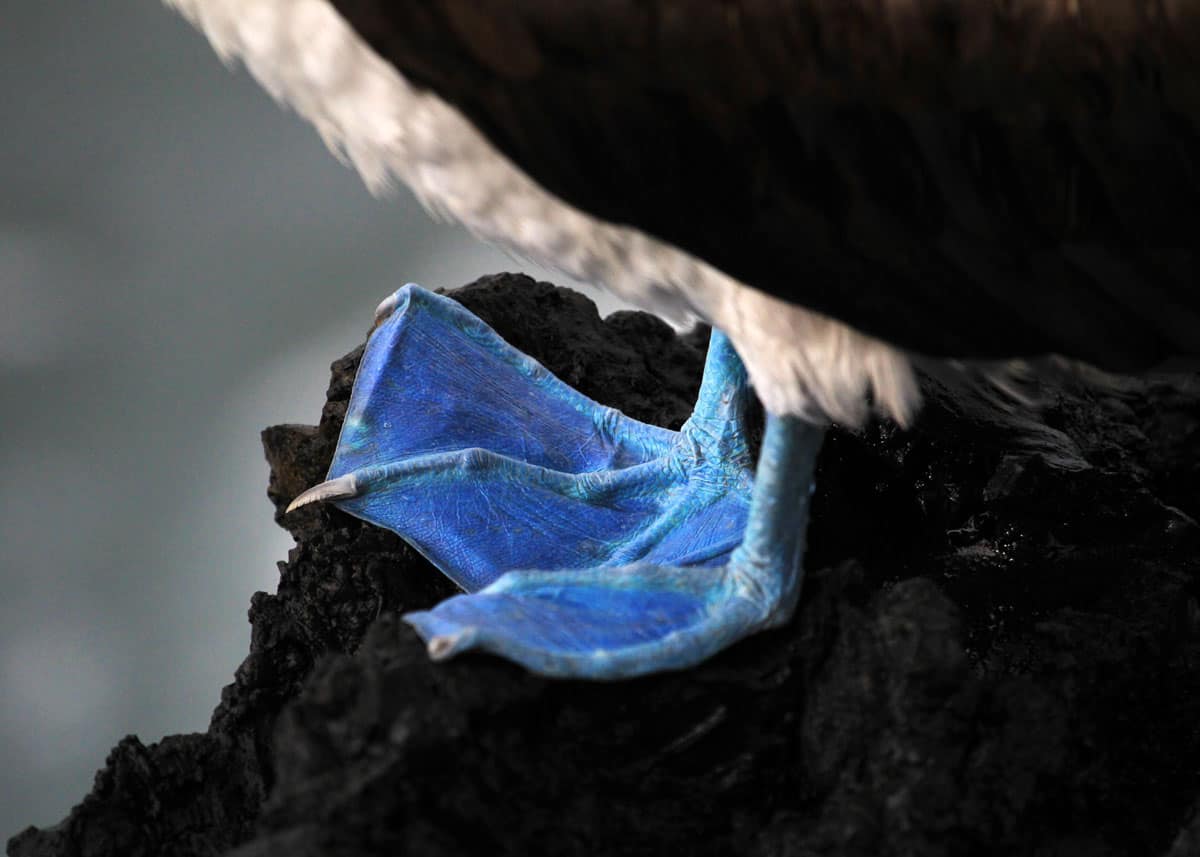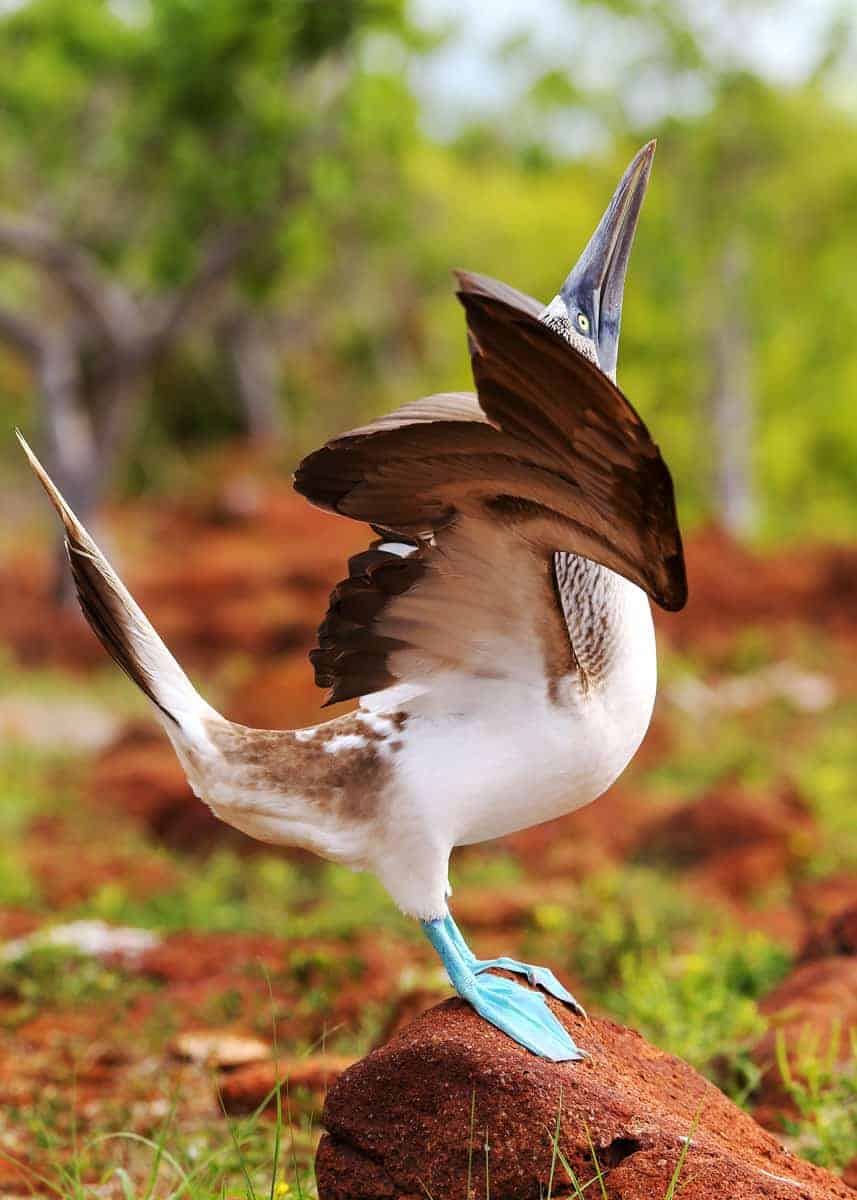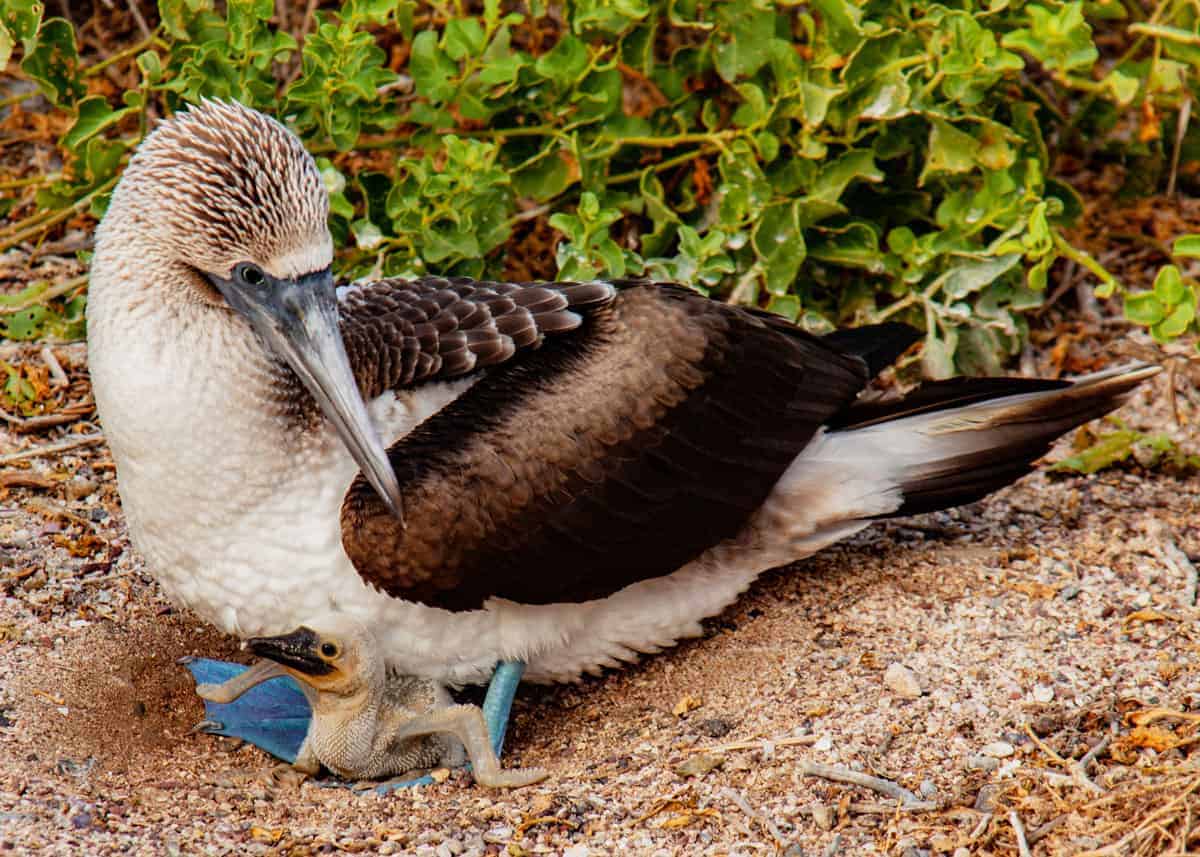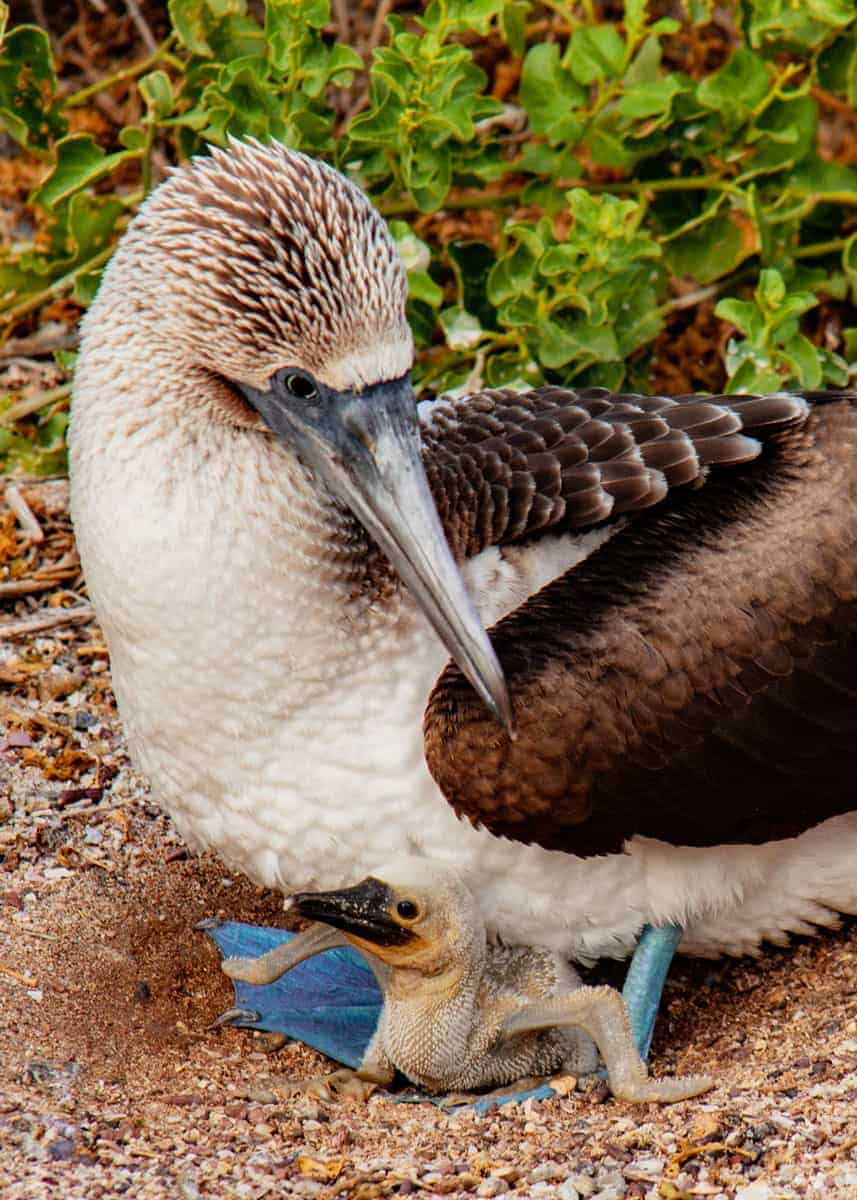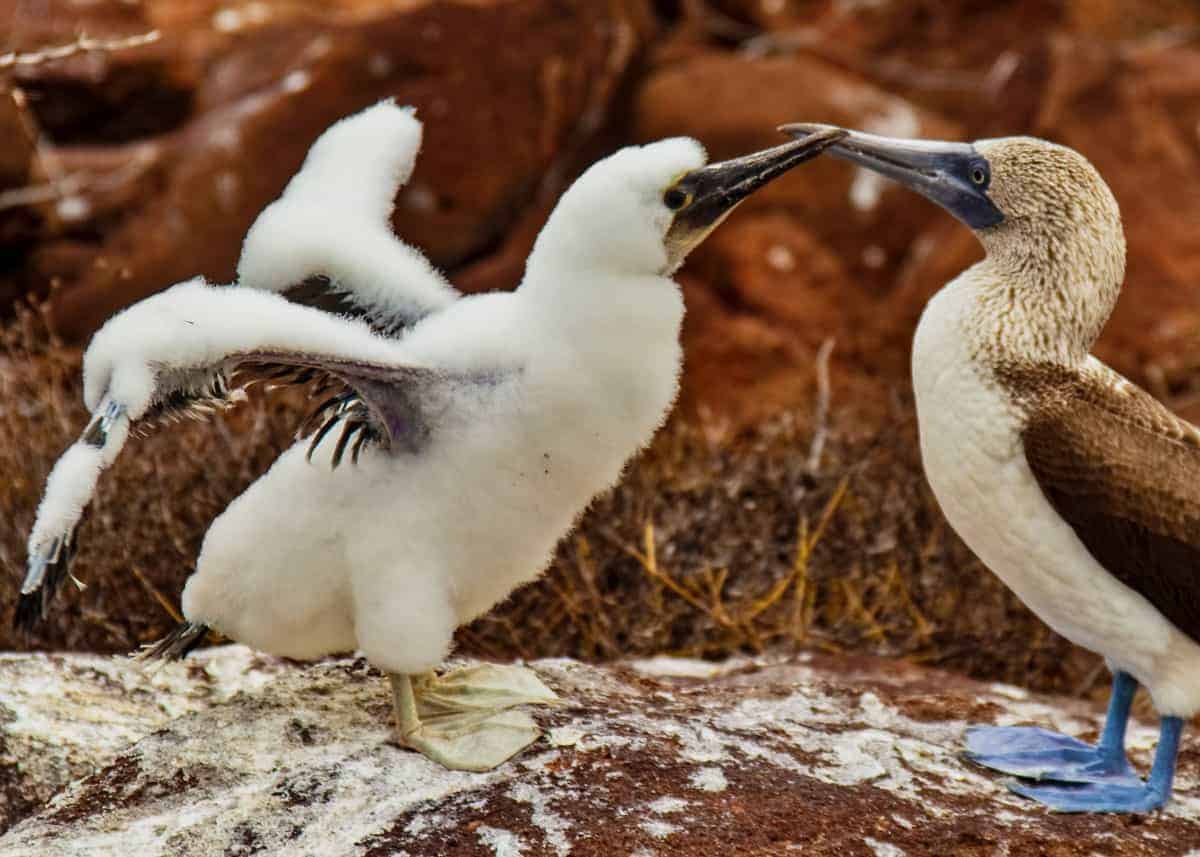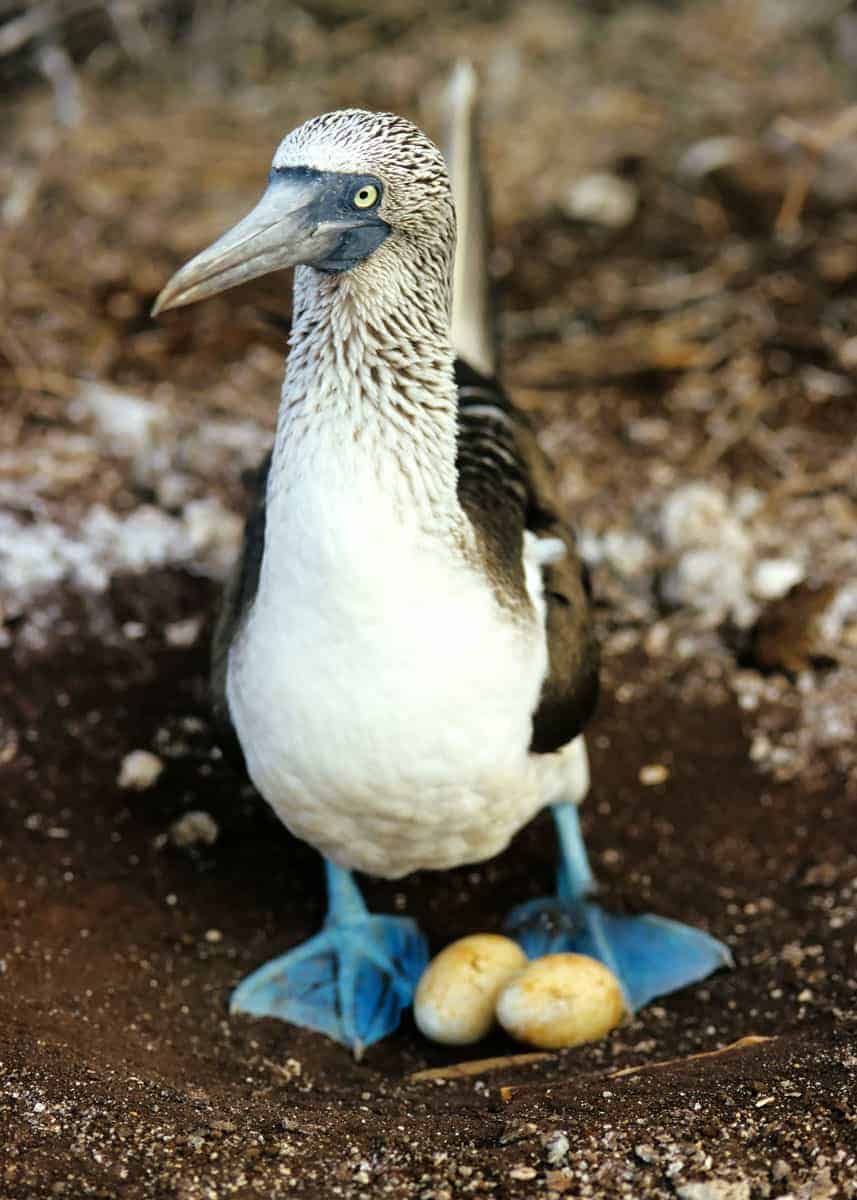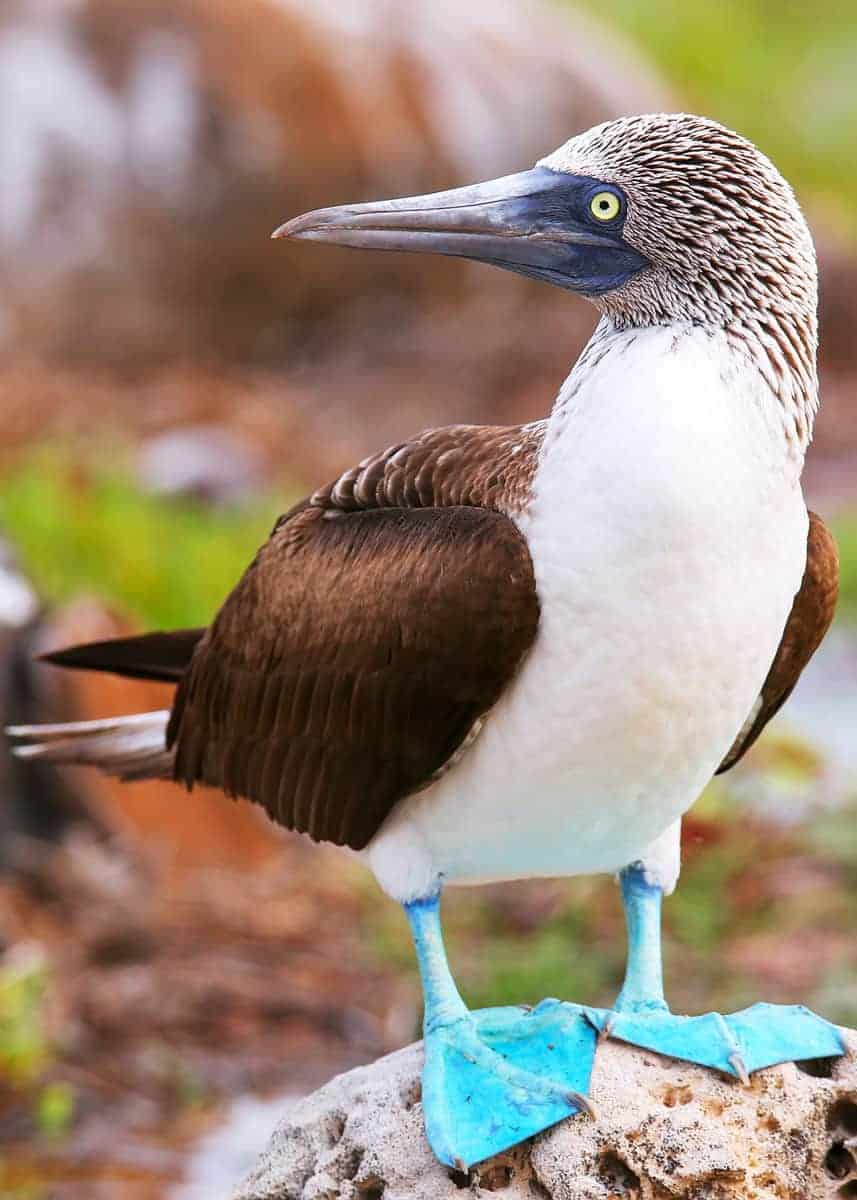43 Blue-footed Booby Facts: Dancing, Dive Bombing Clowns (Sula nebouxii)
The blue-footed booby has become the unofficial mascot of the Galapagos Islands. In this post, you’ll learn 43 blue-footed booby facts, including dancing and mating rituals, diet, dive bombing feeding habits, range and more. Plus tons of photos and videos.
Travel tip: If you’re traveling to the Galapagos, you should bring a camera with a good zoom and a decent pair of binoculars. This will increase the odds of spotting and shooting a blue-footed booby in the wild.
Guide to the Blue-footed Booby
The blue footed booby is one of the most distinctive animals in nature. It’s hard to confuse it for anything else. Even if you miss the bright, turquoise-colored webbed feet, you can recognize the funny waddle or the elaborate courtship dance. It’s the kind of animal that demands to be seen!
But did you know that there’s more to the blue footed booby than its unusual appearance? For example, it can dive-bomb its prey from 100 feet in the air. It builds its nests in hardened black lava. Its chicks frequently kill each other in the nest…
Don’t be fooled by the bizarre face of this sea bird. There’s a lot that you can learn from blue footed booby facts, so let’s get started!
Blue Footed Booby Overview
- Latin name: Sula nebouxii
- Range: The Pacific Coast (America, Mexico, Peru, Chile, Ecuador, Galapagos Islands)
- Population Status: Least Concern
- Size: 32 inches (height), 3.3 pounds (weight)
- Wingspan: 4 – 5 feet
- Diet: Fish
- Physical features: Blue faces, blue feet, white bodies, brown wings, yellow eyes
- Where it lives in Ecuador/Galapagos: Rocky shores and coastlines with nearby land for nesting sites
43 Blue Footed Booby Facts
1. Where does the blue footed booby live?
The blue footed booby lives on the coast of the Pacific Ocean. Its population stretches from the northern beaches of California to the southern islands of Peru.
The largest collection of blue footed boobies can be found at the Galapagos Islands. Roughly half of all breeding pairs nest in the Galapagos.
2. What is the habitat of the blue footed booby?
As a marine animal, the blue footed booby spends most of its time on the water. In fact, one of the reasons why it’s named “booby” is because of the goofy, unnatural way that it walks on land. It just doesn’t get a lot of practice!
The blue footed booby prefers to fly. It soars above various islands and islets as it hunts for food and looks for good nesting sites. It can fly for hours at a time without getting tired, so you’ll only find a blue footed booby on the ground when it needs to rest, nest or lay eggs.
3. Where do blue footed boobies nest?
Blue footed boobies make their nests in shallow depressions on the ground.
On the Galapagos Islands, much of the landscape is hardened black lava, so the boobies will nest in small divots in the lava crust.
They don’t really “build” nests in the traditional sense. They don’t create new structures with twigs or leaves. Instead, they dig into the earth and create a hidey hole that will protect their eggs from predators and keep their chicks from wandering off after they hatch.
The nest eventually develops a ring of excrement, thanks to the female rotating to face the sun during the weeks of nesting on the eggs.
4. What does the blue footed booby look like?
Let’s be honest: The blue footed booby is not a beautiful or graceful creature.
For starters, it has an awkwardly-shaped body that’s designed for flying rather than walking, so it waddles on land like a drunken sailor that might tip over at any minute.
It also has wide yellow eyes on either side of a long, pointed beak; these are great for binocular vision, but they give the booby a permanent expression of surprise.
Its colors are mismatched. Its body is mostly white; its wings are mostly brown or black. The eyes are yellow. The face and beak can range from a neutral gray to a vivid blue, and the feathers surrounding it are streaked with a zebra pattern.
We can’t forget the feet, of course. Like their name implies, blue footed boobies have bright blue feet. The brilliance of the color is linked to the quality of their health, so a vivacious bird will have vivacious feet.
There are a few other oddities to be found on the blue footed booby. For example, it has nostrils that are permanently sealed shut, and its feathered tail is specifically designed for deep-sea diving.
The blue footed booby won’t be winning a beauty contest anytime soon. However, we shouldn’t judge the species too harshly: It’s perfectly adapted to its environment, so even though it might look strange to human eyes, it’s great at survival in the animal kingdom.
5. Are there any subspecies for the blue footed booby?
The blue footed booby comes in two subspecies:
- Sula nebouxii nebouxii is found in North and South America along the Pacific Coast.
- Sula nebouxii excisa is exclusive to the Galapagos Islands.
The species are virtually identical; they just have different geographical ranges. They’re also quite similar to other booby species, including the Peruvian booby (Sula variegata) that shares the same habitat and diet.
6. Why are blue-footed booby feet blue?
Carrots are orange. Flamingos are pink. Blue-footed boobies feet are blue. It’s for the same reason: carotenoids.
Carotenoids are basically all-natural pigments that give bright colors to plants and animals.
In blue-footed boobies, they’re localized in the feet, and they also carry important lipids and lipoproteins that support the booby’s immune system.
Blue feet are also an example of sexual selection. When it’s time to mate, females will choose the males with the brightest feet, so their offspring is predisposed to have bright feet as well.
7. Do blue-footed boobies ever lose color in their feet?
Yes. Since their feet reflect the state of their health, blue-footed boobies lose some of the blue when they’re sick, injured or malnourished.
You can tell right away when you’re looking at a struggling booby: If it has pale, colorless feet, it’s not feeling well.
8. Are blue-footed boobies feet always the same shade of blue?
No. The shade of blue-footed boobies feet ranges from pale turquoise to a dark blue/green (aquamarine).
Females have darker blue feet than males and younger boobies. Males like to visually display the blue of their feet during courtship.
9. How tall is a blue footed booby? Height
The average blue footed booby is around 32 inches tall. Females are usually bigger than males; they can reach 35 inches tall.
10. How much does a blue footed booby weigh?
The blue footed booby weighs between 3 – 4 pounds. Females are usually a bit bigger than males.
11. What is the blue footed boobies wingspan?
The wingspan of the blue footed booby is around 4 to 5 feet.
12. Do blue footed boobies have gills or nostrils?
Blue-footed boobies have nostrils. Blue footed boobies are birds that breathe oxygen, so they have nostrils instead of gills.
However, their nostrils are permanently sealed shut. Since they dive-bomb the water to catch their food, they can’t have jets shooting up their airways whenever they chase a fish!
The flip side to this water advantage is a land disadvantage. The nostrils of a blue-footed booby are completely useless on land. They have to breathe through the corners of their mouths to get air.
13. Do blue footed boobies kill their siblings?
Yes. Among blue-footed boobies it’s common for the stronger sibling to kill the weaker one. This can take place in several ways:
- Direct attack. They might peck their sibling or drag them around by their neck.
- Starvation. They might demand all of the food from mom and dad by making louder noises or distracting them when they go to feed the weaker sibling.
- Abandonment. In shallow nests, they might push their sibling out and force them to fend for themselves.
Their parents may or may not support the infanticide. When food is scarce, the adults might decide to favor the bigger, healthier chick by giving it the lion’s share. Since chicks are completely dependent on their parents finding and regurgitating fish for them, it’s basically a death sentence if they decide not to bother feeding the weaker chick.
Blue-footed boobies aren’t totally callous, however. Females have been observed creating extra-deep nests so that siblings can’t push each other out. They can also ignore the feeding antics of the bigger sibling and make sure that both chicks are fed equally.
They don’t want their babies to die; it’s just something that they’ll permit when times are tough.
14. What’s the difference between facultative and obligate siblicide?
Blue-footed boobies practice facultative siblicide – meaning that the death of the sibling may or may not occur, depending on other environmental conditions.
This is not to be confused with obligate siblicide, meaning that a sibling almost always ends up dying. The Nazca booby is an example of obligate siblicide.
15. How did the blue footed booby get its name?
“Booby” comes from the Spanish word bobo. It means silly, stupid, foolish or clown-like.
It’s a little mean, but put yourself in the shoes of the first explorers who saw blue-footed birds waddling around land and sticking their feet in each other’s faces. You might have considered them bobos too!
16. Are blue footed boobies friendly or aggressive?
Blue footed boobies are tame and docile around humans. If they were ever afraid, they lost that instinct a long time ago; today’s blue footed boobies will waddle around tourists and pay them no more mind than a bug on the ground.
While not exactly sociable, they don’t pose any kind of threat. You don’t have to flee in terror from a blue footed booby.
Towards each other, however, blue footed boobies might be a little more aggressive. Siblings might kill each other, and parents might let it happen.
They’ll get along better once they grow up and start living together in communal groups, but for the first few months of life, it’s definitely a dog-eat-dog world for blue footed boobies.
17. How long do blue footed boobies live?
The average lifespan of a blue footed booby is 15 – 17 years.
18. What eats a blue-footed booby? Predators and Threats
As adults, blue footed boobies don’t have a lot of predators. They aren’t on the menu for many animals, so they just don’t have defensive tools against them.
As eggs, however, blue footed boobies are quite vulnerable to predation. There are lots of creatures that like to snack on bird eggs, including snakes, hawks, gulls, rodents and reptiles. One study found that 47 percent of blue footed booby eggs are eaten by predators within five days of being laid.
Blue footed boobies are safe when they reach adulthood, but getting there can be a challenge!
19. Are the blue footed booby real?
Yes. They might seem like a bizarre creation from a children’s book, but blue footed boobies are very real. You can travel to the Galapagos Islands and see them for yourself.
20. Are blue footed boobies extinct?
Blue footed boobies aren’t extinct. You might be thinking of dodo birds, a lost breed of blue-feathered birds that used to live around the Indian Ocean. They were hunted to extinction in the 1600s.
21. Could blue footed boobies go extinct in the future?
It’s a possibility. Research from Avian Conservation and Ecology has discovered that the population of the blue footed booby has declined by more than 50 percent in recent years.
To make matters worse, a lot of the booby population on the Galapagos Islands is elderly. This could impact both the current generation and future generations to come. Older birds aren’t able to reproduce as often or as successfully as younger ones.
“We need to get to the bottom of [the problem] now rather than five years down the road when you have the equivalent of 75-year-old humans trying to breed.” Dave Anderson, a professor of biology at Wake Forest University.
22. Is the blue footed booby endangered?
Good news! Despite the drop in their population, blue footed boobies aren’t endangered.
Both the International Union for the Conservation of Nature and BirdLife International rank them as “least concern” on the extinction scale. While it’s important to keep an eye on their status, we don’t have to worry just yet.
23. What do blue-footed boobies eat?
It’s all about the seafood for the blue footed booby. They live almost exclusively on fish, including sardines, anchovies and mackerels. They might take down the occasional squid, but it’s rare.
Learn more with these 25 Galapagos Islands Facts.
24. How do blue footed boobies hunt?
Blue footed boobies hunt in groups and dive for fish.
They’ll glide over the water with their eyes and beaks angled downwards so that they can spot the little ripples that signify prey. When they locate a school of fish, they’ll give a whistle to the others, and all of the blue footed boobies will plunge into the water together like synchronized swimmers.
Huge groups of blue footed boobies diving in perfect harmony.
As you’ll see below, it’s a spectacular sight! The boobies can hurdle down from altitudes of 80 – 100 feet or more, hitting the water at speeds of 60 miles per hour. Once they’re in the water, they can dive an additional 80 feet to chase their panicked prey.
When they catch the fish, they swallow them whole. Blue footed boobies don’t have teeth, so they can’t chew. This is why they target small fish like anchovies and sardines.
Blue-footed Booby Feeding Frenzy
Watch almost 1000 blue-footed boobies dive bomb a school of fish at the same time in the Galapagos Islands.
25. What is the blue-footed boobies Latin name?
Sula nebouxii is the Latin name for blue-footed boobies.
There are two subspecies for the blue footed booby: Sula nebouxii nebouxii (native to North and South America) and Sula nebouxii excisa (native to the Galapagos Islands).
Here’s a breakdown of the family tree and scientific name:
- Class: Aves (birds)
- Order: Suliformes (seabirds)
- Family: Sulidae (gannets and boobies)
- Genus: Sula (boobies)
- Species: Sula nebouxii
- Subspecies: Sula nebouxii nebouxii and Sula nebouxii excisa
26. What are blue-footed boobies mating dance and rituals?
Blue footed boobies have elaborate mating rituals that are quite fun to watch.
It starts with the male showing off his blue feet. This is a sign of good health, so he’ll flaunt them with a high-stepping motion to prove his worthiness as a mate.
The next step is bowing. The male will bow his head to the female, and if she’s receptive to his advances, she’ll bow back. If she doesn’t, the male might try another high-step.
The male can try a few other things to impress her, too. He can bring her twigs and fuzzy tufts as nesting gifts, or he can fly around in circles to flash his feet enticingly.
The final mating ritual is the coolest one. Both the male and female will spread their wings while raising their heads to the sky. They might repeat this motion several times, each partner having a turn, until they’re officially ready to mate.
It’s a strange dance, but it’s a necessary one. Blue footed boobies are reluctant to mate unless the proper courtship rituals are followed. It’s just the way that they get things done!
27. Do blue-footed boobies mate for life?
No. Blue footed boobies are monogamous in the sense that they’ll stick with the same mate while raising kids together, but these bonds don’t last. They usually separate after having a clutch.
In fact, blue footed boobies might have several different mates in a short amount of time.
28. At what age do blue footed boobies lay eggs?
Female blue footed boobies reach sexual maturity between 1 – 6 years. Males take a little longer at 2 – 6 years.
29. How often do blue footed boobies lay eggs?
Blue footed boobies lay eggs every 8 – 9 months or so.
They’re opportunistic breeders, so they might hold off on mating when resources are scarce or mate more frequently when conditions are favorable. There are no set seasons for breeding.
30. How long does it take blue footed booby eggs to hatch?
Once the female lays her eggs, it takes around 40 – 45 days for them to hatch.
Mom and dad will both incubate the eggs by covering them with their webbed feet. The webbing gets an increased blood supply from the body, so it’s the most effective way to transfer heat from parent to offspring.
31. How many eggs does the blue footed booby lay?
Blue footed boobies usually lay 2 – 3 eggs per brood. Two is the most common, but three can be achieved in optimal conditions. The eggs are small and blue for the first few days, and they’ll fade to white over time.
Interestingly, the eggs of a blue footed booby aren’t laid all at once. Mom will stagger their arrival by only laying one egg every 4 – 5 days.
Another interesting fact is that blue footed boobies start incubating their eggs as soon as they arrive. This is different from other species where mom will wait until all of her eggs are laid to start incubating them at the same time. The blue footed booby will hop on the first egg and incubate it for several days before laying the second one, and the process will repeat if she lays a third egg.
As a result, the blue footed booby always has one egg that’s larger and better-developed than the other.
This produces a large, dominant “A” chick and a small, subordinate “B” chick. When the fish aren’t biting, the A chick will kill the B chick to keep all of the survival resources for themselves.
32. How do blue-footed boobies protect their eggs from predators?
Since their eggs are frequently stolen by snakes and hawks, blue footed boobies have developed several ways to protect them:
- Camouflage. They’ll cover their white eggs with dirt and sand to help them blend into the nest.
- Feces. It’s common for females to do their business around the nest. This is mostly because they like to face the sun while they incubate, but the foul smell is also used as a deterrent to predators.
- Guarding. Mom and dad will take shifts to guard the eggs when the other is away.
33. What do baby blue footed boobies look like?
Young blue footed boobies are adorable. They’re covered in a fuzzy white down to keep them warm while their feathers grow in, so they look like little cotton balls begging mom and dad for food.
Young boobies also lack the blue feet of their parents. Their feet are white or gray; the blue only develops later.
34. Do blue footed boobies raise their babies together?
Yes. Both males and females will incubate the eggs in the nest, and they’ll take turns feeding the chicks once they hatch.
They’ll go into the water, eat some fish, fly back to the nest and regurgitate their stomach contents for their begging babies.
35. Do blue footed boobies lay bad eggs on purpose?
Not quite. Females are sensitive to breeding and brooding conditions; this is why they only choose the healthiest mates with the brightest feet, and it’s why they’ll favor the strongest chick when times are lean.
This frank approach to reproduction also extends to their eggs. In a study on maternal investment in eggs, researchers found that blue footed boobies laid smaller, weaker eggs when their mates had their feet artificially dulled by makeup. Even if they’d laid a robust egg before the makeover, their next egg was feeble. It was smaller or more fragile, or it had less yolk concentration to support the embryo.
Why does this happen? It’s probably because pale feet are a sign of poor health. The female might be anticipating a future where her sick mate can’t provide a lot of childcare, or she might be preparing for her chicks to come out sick or weak themselves.
In either case, she’ll be facing a greater challenge than usual when the chicks are born, so she’ll lay a “bad” egg or two that requires less care than the others. It’s a way of preemptively reducing her workload.
36. Do blue-footed boobies live in groups?
Blue footed boobies are a mix of social and solitary.
On one hand, they live and hunt in groups, so there’s definitely a communal aspect to their society. They even nest together in densely-packed colonies with hundreds of adults and juveniles living on top of each other.
Additionally, there’s a low level of natal dispersion in blue footed boobies. Adults will often return to the nesting sites of their birth to lay their own eggs. It’s a logical decision: If the nest was good enough to support them to adulthood, it’s good enough for their own babies.
Despite their proximity, however, blue footed boobies aren’t a very affectionate species. Siblings kill each other when there isn’t enough food to go around, and parents basically abandon their young when they’re old enough to survive on their own. There isn’t any playing or grooming. Blue footed boobies eat, sleep, live and grow as individuals.
37. 3 differences between male and female blue-footed boobies
There are a few ways that you can distinguish male and female blue footed boobies:
- Females are slightly bigger than males. While males top out at 32 inches, females can reach 35 inches.
- Males have more yellow in their eyes than females.
- Females can dive deeper into the water than males. Since they’re heavier, they go farther down as they hunt. They can also carry more fish to the surface when they’re done.
38. What is the blue footed booby’s call?
Blue footed boobies have complex methods of communication. They call to each other during hunts; they whistle during their mating rituals. They’re also capable of grunts, yells and shrieks.
Their most famous call is their mating call:
It sounds like a cross between a train whistle and a human yell, so it’s quite distinctive in the wild. If you ever hear this sound in the Galapagos, look around for a blue-footed booby!
39. Are blue footed booby calls unique?
Yes. Studies on blue footed boobies have shown that they have “individual signatures” in their calls, and males and females can recognize the calls of their mates.
It might sound like noise to our ears, but to a blue footed booby, each whistle carries a unique auditory pattern.
40. Are blue footed boobies loud?
Blue footed boobies can get quite loud, especially when it’s time to mate.
Male courtship calls are meant to impress females with their good health, so they aren’t going to modulate their volume levels. They’re trying to strut their stuff!
41. Do blue footed boobies carry disease?
Blue footed boobies don’t carry any known diseases. They might have an internal parasite or two, but this only affects their own health and not the health of humans. They’re safe to be around.
42. Where can I see the blue-footed booby?
It can be difficult to observe blue footed boobies in real life. They’re not endangered, but they’re generally only kept in rescues and wildlife sanctuaries, and they aren’t held in these places for long. Sea birds don’t fare well in captivity. This means that you won’t find the blue-footed booby in a zoo.
If you want to see a blue footed booby in the wild, your best bet is to travel to the Galapagos Islands. While they’re located up and down the whole of the Pacific Coast, there’s a concentrated population in the Galapagos Islands, and special tours can take you to their favorite hunting and nesting spots.
You should know, however, that you won’t be allowed to interact with the boobies. There are strict rules on the Galapagos Islands about maintaining your distance from the animals. This is meant to protect them and their way of life, so buy a long-range lens for your camera and stay back!
43. 3 Types of Galapagos Boobies
You’ll find three types of booby birds in the Galapagos Islands: Nazca, red-footed, and blue-footed.
Boobies belong to the genus Sula. Globally, there are 6 species of boobies. The Sula species that aren’t found in the Galapagos are the brown, masked, and Peruvian booby.
Learn more about other Galapagos Island animals in our guide.
Your Turn
Between their odd appearance and even odder habits, blue footed boobies are some of the most unique animals on the planet. But isn’t that what makes nature so great?
We hope that you learned something from these blue-footed booby facts! If you have something to add please share by leaving a comment.

